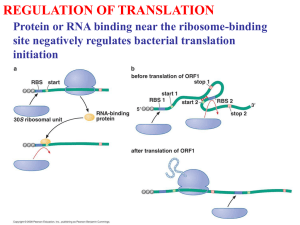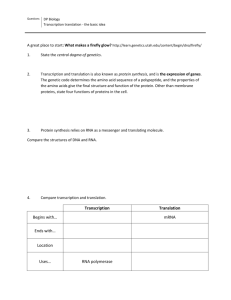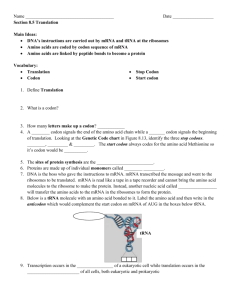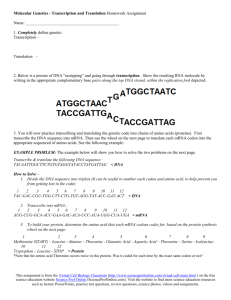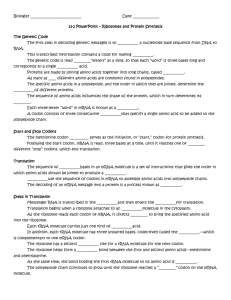CHAPTER 15
advertisement
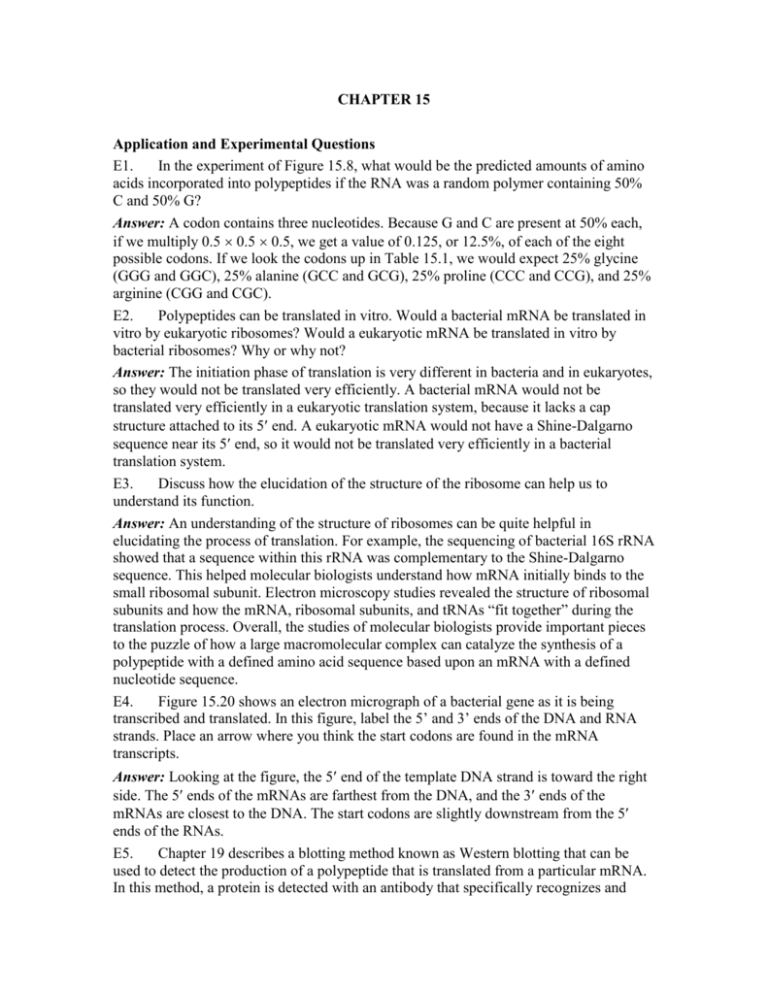
CHAPTER 15 Application and Experimental Questions E1. In the experiment of Figure 15.8, what would be the predicted amounts of amino acids incorporated into polypeptides if the RNA was a random polymer containing 50% C and 50% G? Answer: A codon contains three nucleotides. Because G and C are present at 50% each, if we multiply 0.50.50.5, we get a value of 0.125, or 12.5%, of each of the eight possible codons. If we look the codons up in Table 15.1, we would expect 25% glycine (GGG and GGC), 25% alanine (GCC and GCG), 25% proline (CCC and CCG), and 25% arginine (CGG and CGC). E2. Polypeptides can be translated in vitro. Would a bacterial mRNA be translated in vitro by eukaryotic ribosomes? Would a eukaryotic mRNA be translated in vitro by bacterial ribosomes? Why or why not? Answer: The initiation phase of translation is very different in bacteria and in eukaryotes, so they would not be translated very efficiently. A bacterial mRNA would not be translated very efficiently in a eukaryotic translation system, because it lacks a cap structure attached to its 5 end. A eukaryotic mRNA would not have a Shine-Dalgarno sequence near its 5 end, so it would not be translated very efficiently in a bacterial translation system. E3. Discuss how the elucidation of the structure of the ribosome can help us to understand its function. Answer: An understanding of the structure of ribosomes can be quite helpful in elucidating the process of translation. For example, the sequencing of bacterial 16S rRNA showed that a sequence within this rRNA was complementary to the Shine-Dalgarno sequence. This helped molecular biologists understand how mRNA initially binds to the small ribosomal subunit. Electron microscopy studies revealed the structure of ribosomal subunits and how the mRNA, ribosomal subunits, and tRNAs “fit together” during the translation process. Overall, the studies of molecular biologists provide important pieces to the puzzle of how a large macromolecular complex can catalyze the synthesis of a polypeptide with a defined amino acid sequence based upon an mRNA with a defined nucleotide sequence. E4. Figure 15.20 shows an electron micrograph of a bacterial gene as it is being transcribed and translated. In this figure, label the 5’ and 3’ ends of the DNA and RNA strands. Place an arrow where you think the start codons are found in the mRNA transcripts. Answer: Looking at the figure, the 5 end of the template DNA strand is toward the right side. The 5 ends of the mRNAs are farthest from the DNA, and the 3 ends of the mRNAs are closest to the DNA. The start codons are slightly downstream from the 5 ends of the RNAs. E5. Chapter 19 describes a blotting method known as Western blotting that can be used to detect the production of a polypeptide that is translated from a particular mRNA. In this method, a protein is detected with an antibody that specifically recognizes and binds to its amino acid sequence. The antibody acts as a probe to detect the presence of the protein. In a Western blotting experiment, a mixture of cellular proteins is separated using gel electrophoresis according to their molecular masses. After the antibody has bound to the protein of interest within a blot of a gel, the protein is visualized as a dark band. For example, an antibody that recognizes the β-globin polypeptide could be used to specifically detect the β-globin polypeptide in a blot. As shown here, the method of Western blotting can be used to determine the amount and relative size of a particular protein that is produced in a given cell type. [Insert Text Art 15.1] Lane 1 is a sample of proteins isolated from normal red blood cells. Lane 2 is a sample of proteins isolated from kidney cells. Kidney cells do not produce βglobin. Lane 3 is a sample of proteins isolated from red blood cells from a patient with βthalassemia. This patient is homozygous for a mutation that results in the shortening of the β-globin polypeptide. Now here is the question. A protein called troponin contains 334 amino acids. Because each amino acid weighs 120 Daltons (on average), the molecular mass of this protein is about 40,000 Daltons, or 40 kDa. Troponin functions in muscle cells, and it is not expressed in nerve cells. Draw the expected results of a Western blot for the following samples: Lane 1: Proteins isolated from muscle cells Lane 2: Proteins isolated from nerve cells Lane 3: Proteins isolated from the muscle cells of an individual who is homozygous for a mutation that introduces a stop codon at codon 177 Answer: E6. The technique of Western blotting can be used to detect proteins that are translated from a particular mRNA. This method is described in Chapter 19 and also in experimental question E5. Let’s suppose a researcher was interested in the effects of mutations on the expression of a structural gene that encodes a protein that we will call protein X. This protein is expressed in skin cells and contains 572 amino acids. Its molecular mass is approximately 68,600 Daltons, or 68.6 kDa. Make a drawing that shows the expected results of a Western blot using proteins isolated from the skin cells that were obtained from the following individuals: Lane 1: A normal individual Lane 2: An individual who is homozygous for a deletion, which removes the promoter for this gene Lane 3: An individual who is heterozygous in which one gene is normal and the other gene had a mutation that introduces an early stop codon at codon 421 Lane 4: An individual who is homozygous for a mutation that introduces an early stop codon at codon 421 Lane 5: An individual who is homozygous for a mutation that changes codon 198 from a valine codon into a leucine codon Answer: E7. The protein known as tyrosinase is needed to make certain types of pigments. Tyrosinase is composed of a single polypeptide with 511 amino acids. Because each amino acid weighs 120 Daltons (on average), the molecular mass of this protein is approximately 61,300 Daltons, or 61.3 kDa. People who carry two defective copies of the tyrosinase gene have the condition known as albinism. They are unable to make pigment in the skin, eyes, and hair. A blotting method known as Western blotting can be used to detect proteins that are translated from a particular mRNA. This method is described in Chapter 19 and also in experimental question E5. Skin samples were collected from a normal individual (lane 1), and from three unrelated albino individuals (lanes 2, 3, and 4), and subjected to a Western blot analysis using an antibody that recognizes tyrosinase. Explain the possible cause of albinism in the three albino individuals. [Insert Text Art 15.2] Answer: The sample in lane 2 came from an individual who is homozygous for a mutation that introduces an early stop codon into the coding sequence. As seen in lane 2, the protein is shorter than normal. The sample in lane 3 came from an individual who was homozygous for a mutation that prevented the expression of this polypeptide. It could be a down promoter mutation (i.e., a mutation in the promoter that decreases the rate of transcription), or it could be a mutation in the coding sequence that causes the protein to be degraded very rapidly. The sample in lane 4 came from an individual who is homozygous for a mutation that changed one amino acid to another amino acid. This type of mutation, termed a missense mutation, may not be detectable on a gel. However, a single amino acid substitution within a polypeptide may block protein function, which would explain the albino phenotype. E8. Although 61 codons specify the 20 amino acids, most species display a codon bias. This means that certain codons are used much more frequently than other codons. For example, UUA, UUG, CUU, CUC, CUA, and CUG all specify leucine. In yeast, however, the UUG codon is used to specify leucine approximately 80% of the time. A. The experiment of Figure 15.8 shows the use of an in vitro or cell-free translation system. In this experiment, the RNA, which was used for translation, was chemically synthesized. Instead of using a chemically synthesized RNA, researchers can isolate mRNA from living cells and then add the mRNA to the cell-free translation system. If a researcher isolated mRNA from kangaroo cells and then added it to a cellfree translation system that came from yeast cells, how might the phenomenon of codon bias affect the production of proteins? B. Discuss potential advantages and disadvantages of codon bias for translation. Answer: A. If codon usage were significantly different between kangaroo and yeast cells, this would inhibit the translation process. For example, if the preferred leucine codon in kangaroos was CUU, translation would probably be slow in a yeast translation system. We would expect the cell-free translation system from yeast cells to primarily contain leucine tRNAs with an anticodon sequence that is AAC, because this tRNALeu would match the preferred yeast leucine codon, which is UUG. In a yeast translation system, there probably would not be a large amount of tRNA with an anticodon of GAA, which would match the preferred leucine codon, CUU, of kangaroos. For this reason, kangaroo mRNA would not be translated very well in a yeast translation system, but it probably would be translated to some degree. The advantage of codon bias is that a cell can rely on a smaller population of tRNA molecules to efficiently translate its proteins. A disadvantage is that mutations, which do not change the amino acid sequence but do change a codon (e.g., UUG to UUA), may inhibit the production of a polypeptide if a preferred codon is changed to a nonpreferred codon.

